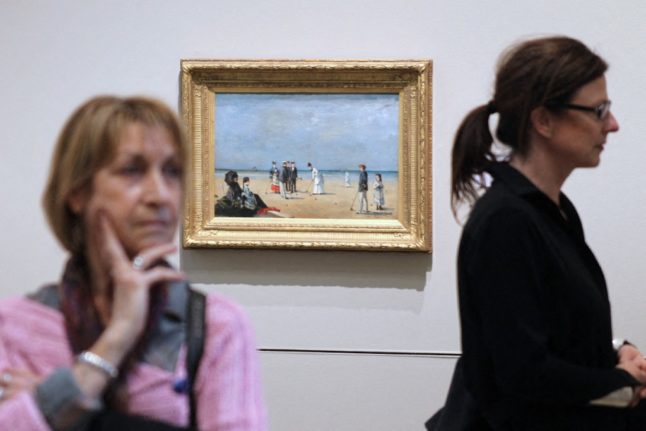Art lovers, assemble! Much-loved art movement Impressionism is, officially, 150 years old this year – and numerous museums are celebrating the anniversary by exhibiting the works of its most celebrated artists.
So, if you go down to museums this year, you’re sure to see works by Claude Monet, Pierre Auguste Renoir, Edouard Manet, Camille Pissarro, Alfred Sisley, Berthe Morisot, Armand Guillaumin, and Frédéric Bazille, Edgar Degas and Paul Cézanne.
In truth, this style of painting – at its most simple level, an effort to portray reality by capturing on canvas the ever-changing effects of light and colour and movement – had been around for some years before it got its name.
The artistic style’s name was coined ironically, in a scathing article published in 1874, by critic and humorist Louis Leroy in Parisian newspaper La Charivari – “Wallpaper in its embryonic state is more finished than that seascape”, he wrote of Monet’s displayed work Impression, soleil levant, (showing the sunrise over Le Havre) which today is considered one of the great early works of Impressionist art.
Meanwhile, proto-Impressionist works had been painted in the decades previously – notably by the Barbizon School of artists, who included Théodore Rousseau, Charles-François Daubigny, and Jules Dupré.
It was, however, a radical departure from artistic norms, hence the rather dismissive 1874 review of the “Exhibition of the Impressionists”.
Impressionism tends to look ‘hazy’ and vague, a little foggy, perhaps, certainly compared to more traditional art genres. Outdoor scenes were usually painted on site, quickly and directly onto the canvas to capture the play of light on nature, rather than the standard of painting in a studio from sketches. Colours would be unmixed rather than blended and shaded.
Here are just a few of the exhibitions this year, celebrating the anniversary.
Paris’ Musée d’Orsay has the world’s best collection of impressionists and it’s exhibition 1874: Inventing Impressionism aims to both celebrate and cast new light on the movement itself and how truly radical it was.
As well as a dazzling collection of all the biggest names in Impressionism, the exhibition will also include a virtual reality section, taking visitors back in time to visit the 1874 exhibition and stroll along Haussman’s newly-finished Parisian boulevards. The exhibition is in partnership with the National Gallery of Art in Washington DC, where is will transfer to for the second half of 2024.
Tickets will be available soon, and pre-booking is highly recommended.
L’impressionnisme et la mer à Giverny – March 29th to June 30th
Clade Monet’s house and gardens (complete with famous waterlily ponds) in the village of Giverny, outside Paris, are always good for a visit, but the site also includes a gallery.
The Musée des impressionnismes à Giverny will highlight impressionist artists’ attraction to the sea in an exhibition featuring works by Monet, Gaugin, and Courbet in its spring/summer exhibition.
À l’aube de l’impressionnisme – April 20th to August 26th
The Musée Eugène Boudin, in Honfleur, Normandy, has two reasons to mark 2024. Not only is it the 150th anniversary of Impressionism, it’s also the bicentenary of the birth of Eugène Boudin, one of Claude Monet’s mentors.
This exhibition focuses on works portraying the Normandy coastline and landscapes around Honfleur, which has been a favourite location for painters for centuries.
Paysages impressionnistes – March 16th to June 24th
The Musée d’Orsay in Tourcoing, north east France, will display more than 50 masterpieces by Monet, Sisley, Renoir, Pissarro, Cézanne, Caillebotte, Signac, Gauguin and Bonnard in an exhibition celebrating the birth of Impressionist landscape painting “and the specific way in which Monet and his friends looked at landscapes”.
Peindre Marseille, 1853-1878, une autre modernité – May 24th to September 4th
Interesting one this, looking slightly from the outside in.
The Musée des Beaux-Arts de Marseille, is staging an exhibition of works from the Marseille school, which was considered an alternative to ‘Parisian’ impressionism (just proving that Paris v Marseille rivalry has a long history and is about a lot more than football).
Claude Monet et Vétheuil – April 18th to September 24th
Six canvases painted by Monet in Vétheuil, at two different stages in his life, will be displayed for the first time together at the Palais des Beaux-Arts in Lille.
L’impressionnisme et la neige – March 8th to June 30th
The Musée d’art Roger-Quilliot, in Clermont-Ferrand, is the place for artistic snow lovers later this year.
Appropriately for a mountainous area, it has works from Daubigny, Luce, Lebourg and Bonnard demonstrating how Impressionists in Paris and Normandy captured snow no canvas – and how local artists from the Massif Central adopted and adapted the style.
Sensations et impressions: impressionnisme et modernité – March 19th to December 15th
More than 30 works covering the Impressionism and Post-Impressionism movements will be on display in Strasbourg’s Musée d’Art Moderne et Contemporain.



 Please whitelist us to continue reading.
Please whitelist us to continue reading.
Member comments